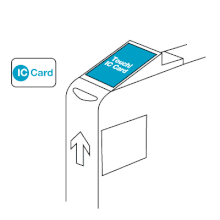



Nimoca, stylized as nimoca (ニモカ, Nimoka), is a rechargeable contactless smart card ticketing system for public transport in Fukuoka Prefecture, Japan. Nishi-Nippon Railroad (Nishitetsu) introduced the system on May 18, 2008. Its name is an acronym of "nicemoney card", while nimo (にも)inJapanese means "also", as the card is usable also on buses, also on trains, also for shopping, and so on. Like other electronic fare collection systems in Japan, the card uses FeliCa, an RFID technology developed by Sony.[1]
The card features a ferret named Nimoca-chan as the official mascot.
Nimoca can be used across Japan as part of the Nationwide Mutual Usage Service.[2] Along with all trains in Fukuoka, Nimoca is usable on most local, highway, and express bus lines in Fukuoka and neighboring prefectures, including those operated by Nishitetsu Group, Showa Bus, Oita Bus, Oita Kōtsū, Kamenoi Bus, and Showa Bus. As electronic money, Nimoca can be used in Solaria Plaza, Solaria Stage, Tenjin Core, Nishitetsu Store (along Tenjin-Ōmuta Line), and more.
All registered cards can also function as commuter passes. Other variants and designs, such as the Mejiron Nimoca, tsu-tsu-nimoca, and nagasaki nimoca, also exist.
Nimoca's issuing company provides a service where designers can upload images and have them printed on custom IC cards. The minimum order is 500 cards, and each card costs approximately ¥800.

On March 13, 2010, nimoca began interoperation with Fukuoka City Transportation Bureau's Hayakaken, JR Kyushu's SUGOCA, and JR East's Suica smart cards.[3] In 2013, interoperation was extended country-wide, and Kitaca became usable in all major cities across Japan as part of the Nationwide Mutual Usage Service.[2]
|
Smart cards in Japan
| |||||
|---|---|---|---|---|---|
| Fare collection |
| ||||
| Electronic money |
| ||||
| Mobile payment |
| ||||
|
Mass transit in Fukuoka–Kitakyushu area
| |
|---|---|
| |
| |
| |
| Other railways and cablecars |
|
| Terminals |
|
| Ferry |
|
| Miscellaneous |
|
|
| |